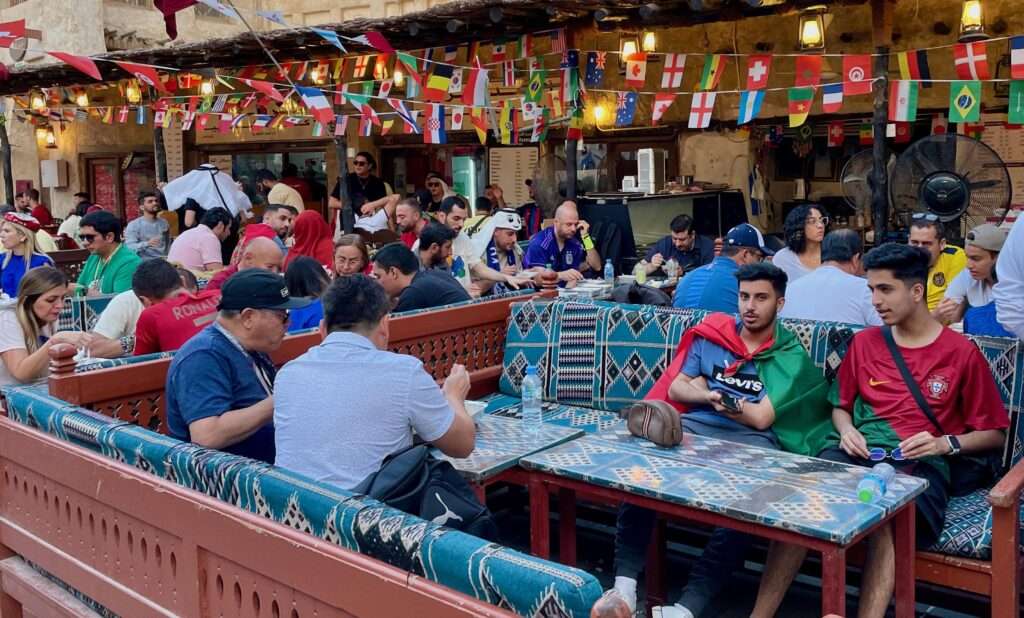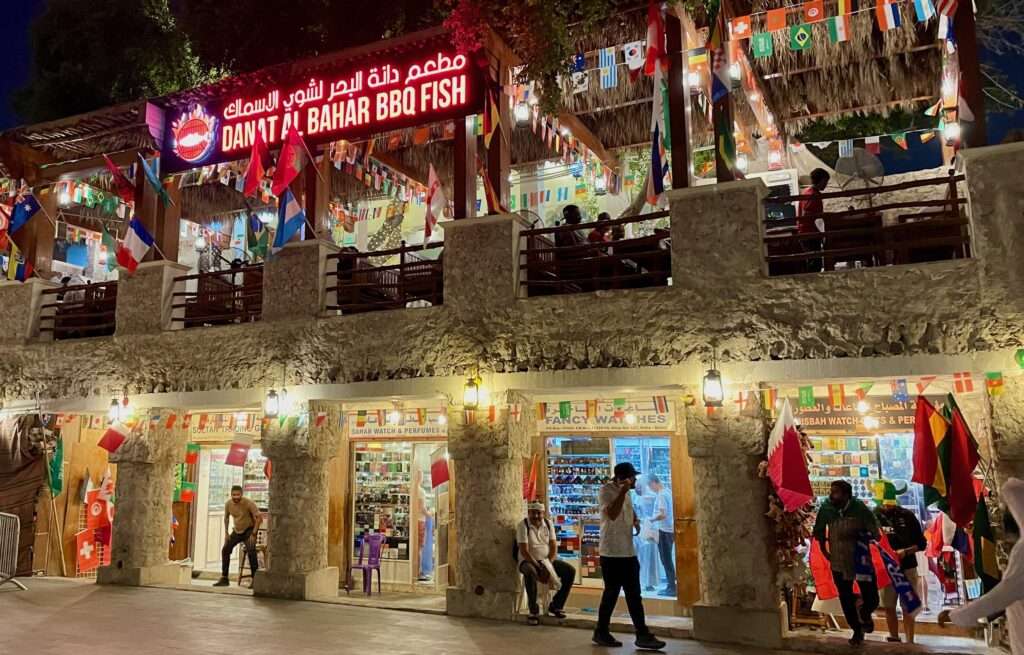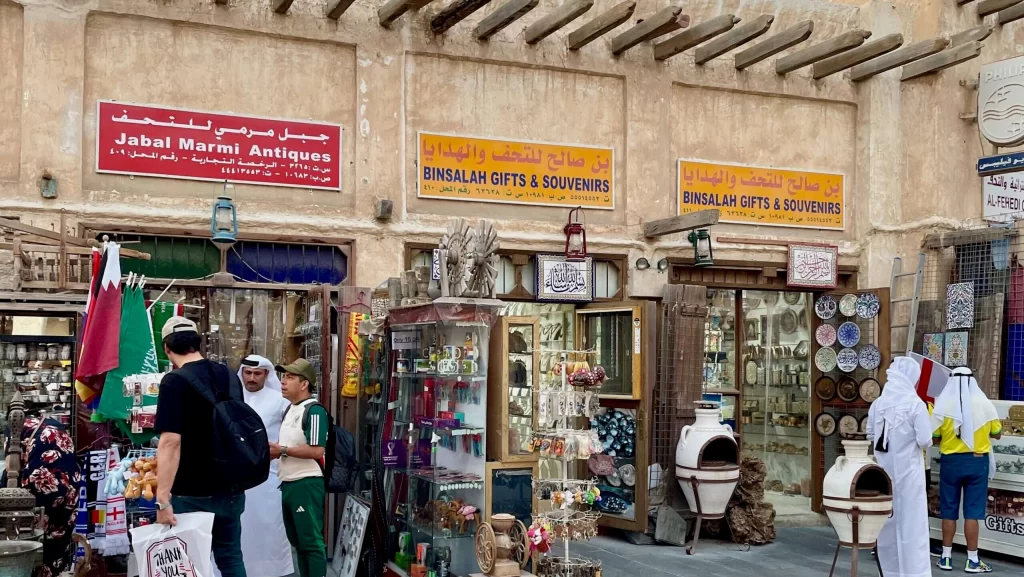Doha’s Souq Waqif is exceptional in so many ways. I have been to city souqs in the UAE and Oman but this was something else. It was bigger than other city souks and for the size of the country.
When I landed in Qatar for the World Cup , the focus and attention was on football. But the visit to the Souq on the first night was captivating. And I returned every night except for the last night I was there.
I realised that the country decided to showcase their souq. And why not? As a place for gathering, celebration and for food and drinks. It turned out to be the perfect stage.
It helped as it was in the centre of the city. Next to the main transport hub for the metro and buses there.
One important thing to note is the opening hours which has an afternoon break. Souq Waqif opens at 10am to 12 noon and then from 4pm to past 10pm. Probably to address the searing summer heat noted across the Middle East.
Best time to visit is just after dusk, when lights come on. Not only cooler but the things come alive and the place looks much better. I noticed this of the Middle East. If you are tourist, sleep in and plan to stay late at night.


Middle Eastern Souq
A souq is a marketplace or bazaar in the Middle East and in North Africa. Arab and Muslim in origin.” Bazaar”, is the Persian version and is akin to the Souqs of the Arab World. In Israel it is called “Shuk” in Hebrew.
It allows producers and traders primarily in the field of agriculture to bring their produce and livestock for sale. The buyers can be household consumers or wholesalers. Some of whom would then trade these to other parts and to other countries.
The main reasons the Souqs stand out from the marketplaces around the World is what one sees. Centuries bound tradition, culture and history that are clearly evident in souks of the Middle East.


Tradition, culture and history
Think Arabian nights. Aladdin’s cave, magic carpet, genie from a lamp etc and you are not far from it when you enter a souk at night.
The Souq in Oman’s Corniche even resembles a cave in some parts. It adds to the captivating atmosphere and mood of a long gone past era.

You see hundreds of lamps, the carpets, coins, daggers, swords and ancient ornaments. In a labyrinth of passageways, alleys lined with tiny shops, not knowing what the next turn reveals. Sometimes cave like architecture prevails and you know that it is not the usual market place.
Deep down you are hoping that the lamp you buy can be rubbed. And why not?
And these things are no made in the Far East. They are made with the same materials and in the same way. Very much ancient and authentic looking.

You literally can start a memorable and revered collection of antiques right there and then. Its looks like time stood still. An opportunity and occasion not to be missed.
Adding to the old World charm is the presence of porters and their carts of the old World. Still bringing in stock to the shops as they did for decades.

The atmosphere and ambience
It is not just the goods and products that are being sold. The layout as well. It’s also about look of traders, their garb, their mannerisms, the haggling that is done. It’s from an entirely different era.

Things for sale
Souq Waqif is large and therefore has much to offer. Diverse would be an understatement. It starts with household goods, pots and pans, clothes, spices, carpets to parrots and Falcons. In the old days, camels and horses too.
The thing that hits you first and all your senses are spices. The range and colours are impressive and the smells are intense. Saffron, cloves to cardamon. It’s all there including spices that you have never seen or heard before.
Some of the items for sale tell a story. The variety and sizes of pots and pans tells us that they are not just for the house but for big outdoor events and cooking takes place outside for a very large group. And there is no commercial stove or gas burner that can provide heat consistently for larger pots. It has to be over a wood or coal fired pit. The traditional way.
Spices
Spices are the signature product in Souqs and Souq Waqif is no different. The spices come from far and wide. The Arabs have known to be spice traders across the eastern trade routes. All the way to Singapore and Indonesia. At a time when the Portuguese, Dutch and later the British reached out to the Far East.
I have been to traditional markets in South Asia and South East Asia where spices are central to their cuisine. Yet their range and prominence is a step down from Souks of the Middle East.
The mystery is if all these spices are actually used in Middle Eastern cuisine. Or are they are centre of the spice trade for half the World. Saffron might tell a tale. Iran is the World’s largest producer of saffron but they are prominently traded in these Souks and in large amounts.
Souqs within Souq
Souq Wakif has product zones which are also called Souqs. There is the Gold Souq, the Oud and Arabic Perfume Souq, the Bird Souq and the Falcon Souq. And finally antiques and handicrafts.
The visit to the Oud and Perfume Souq is highly recommended as the range and smells are diverse.
I was not aware of the association of Arabs to perfumes and scented oils until my first visit to the Middle East. You see perfumes shops and their sales staff offering a sniff of their products everywhere. From modern malls to traditional souqs.
Other than spices and perfumes, Gold is another prominent feature. Though I not sure if they were part of the traditional souk or a recent addition. Drawn by the foot traffic of the traditional Souqs.
Middle Eastern Cuisine
Food and the Middle East Cuisine is prominent at Souq Wakif. An attraction by itself. It did not have to complement their traditional produce and wares sold at the Souq. It draws it own crowd.

Middle East cuisines from local Qatar to Iraq, Syria, Lebanon, Yemeni to Egyptian take centre stage. Followed by Indian, Thai and Azerbaijani.
These restaurants are well spread and enticing. The nuances and variations in practices and food custom are noticeable despite the regional similarity.
The restaurants themselves are interesting in appearance and the ambience they create.
The future of Souq Waif
Like all markets, souqs and bazaars, it too will evolve. My guess is that Souq Waqif is relatively large and has dept in comparison to others in the Gulf. It will continue in its current form for a very long time. Maybe more restaurants and cuisines of the region will emerge and help retain its character. If you have not been to one, this is one to start with.
Here is the informative official website to Souq Waqif here.
